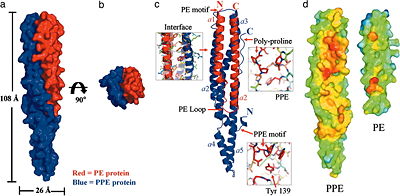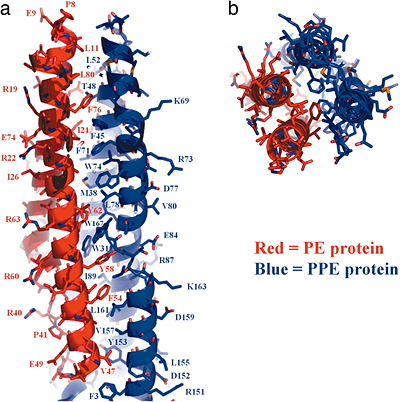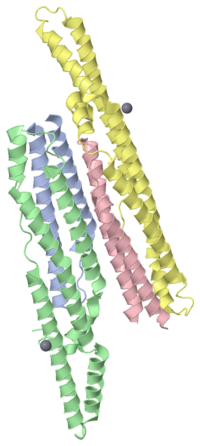A PE/PPE Protein Complex from Mycobacterium tuberculosis
The heterodimeric from M. tuberculosis is composed of a 99 amino acid protein (Rv2431c, shown in RED) and a 194 amino acid (Rv2430c, shown in BLUE), that are encoded next to each other on the M. tuberculosis genome (suggestive of a potential operon). These proteins represent two of the largest protein families in the M. tuberculosis genome. The PE and PPE proteins form an , reminiscent of a four-helix bundle, which can be best viewed down the . The protein interaction between the two proteins is lined with hydrophobic residues, contributing to the stability of the protein complex. Click here to view a representation.
Publication Abstract from PubMed
The developing science called structural genomics has focused to date mainly on high-throughput expression of individual proteins, followed by their purification and structure determination. In contrast, the term structural biology is used to denote the determination of structures, often complexes of several macromolecules, that illuminate aspects of biological function. Here we bridge structural genomics to structural biology with a procedure for determining protein complexes of previously unknown function from any organism with a sequenced genome. From computational genomic analysis, we identify functionally linked proteins and verify their interaction in vitro by coexpression/copurification. We illustrate this procedure by the structural determination of a previously unknown complex between a PE and PPE protein from the Mycobacterium tuberculosis genome, members of protein families that constitute approximately 10% of the coding capacity of this genome. The predicted complex was readily expressed, purified, and crystallized, although we had previously failed in expressing individual PE and PPE proteins on their own. The reason for the failure is clear from the structure, which shows that the PE and PPE proteins mate along an extended apolar interface to form a four-alpha-helical bundle, where two of the alpha-helices are contributed by the PE protein and two by the PPE protein. Our entire procedure for the identification, characterization, and structural determination of protein complexes can be scaled to a genome-wide level.
Toward the structural genomics of complexes: crystal structure of a PE/PPE protein complex from Mycobacterium tuberculosis., Strong M, Sawaya MR, Wang S, Phillips M, Cascio D, Eisenberg D, Proc Natl Acad Sci U S A. 2006 May 23;103(21):8060-5. Epub 2006 May 11. PMID:16690741
From MEDLINE®/PubMed®, a database of the U.S. National Library of Medicine.
About this Structure
2G38 is a Protein complex structure of sequences from Mycobacterium tuberculosis h37rv. Full crystallographic information is available from OCA.

Above depicts the crystal structure of the M.tb. PE/PPE protein complex (Adapted from Strong et al. PNAS 103: 8060–8065 ). (a) Surface representation of the PE/PPE protein complex. The PE protein Rv2431c is shown in red, and the PPE protein Rv2430c is in blue. (b) The PE/PPE protein complex viewed down its longitudinal axis. (c) Ribbon diagram of the PE/PPE protein complex. The complex is composed of seven α-helices. Two α-helices of the PE protein interact with two helices of the PPE protein to form a four-helix bundle. Regions of high sequence conservation are indicated by arrows and discussed in the text. (d) Interface hydrophobicity of the PPE and PE proteins. The hydrophobicity of the interaction interface between the PPE and PE protein is color-coded: the most apolar regions are indicated in red, orange, and yellow, and the most polar regions are indicated in blue. Notice the extensive apolar regions that are shielded from solvent as the complex forms. (Text and Figure adapted from Strong et al. Proc Natl Acad Sci U S A. 103: 8060–8065 (2006), Figure 3).

Interaction interface of the PE/PPE protein complex. (a) Two helices of the PE protein, α1 and α2, interact with two helices of the PPE protein, α2 and α3, to form a four-helix bundle. The four-helix-bundle is largely stabilized by hydrophobic interactions among apolar side chains, as seen in the core of the complex. In contrast, the outer surface is coated with polar residues. (b) The PE/PPE complex as viewed down the longitudinal axis (Text and Figure adapted from Strong et al. Proc Natl Acad Sci U S A. 103: 8060–8065 (2006), Figure 4).



